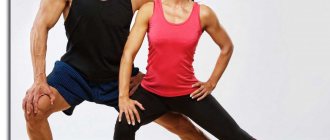How to find out whether muscles have recovered after training or not
In order to get good results from a new workout, the muscles must fully recover from the previous session. How long muscle recovery will take depends on several factors, primarily the type of exercise and its intensity, current physical fitness and state of health. In this material you will find the answer to the question of how much rest you need between workouts. Here are also the best ways to make muscle recovery faster.
In order for training to be productive, muscles must have time to recover between them. But how do you understand how long it will take for muscle recovery and how much rest you need before training?
You may have heard of 48 hours or 72 hours, some people prefer to give each muscle group a week of rest. In fact, there is no exact figure; muscle recovery time varies for each muscle group and for each person.
When we talk about recovery, we mean the period that is required to fully restore strength. After this period, the muscles are ready to return to optimal load levels; the higher the intensity of the training, the more the muscles are injured and the more time it takes to restore strength.
How to take a break
One effective way to plan a break is to determine in advance how long you will not exercise. This could be a day, a week, or even a month, depending on your situation. Once the time period is determined, decide that you will strictly adhere to it. Just let this period be sufficient for your complete rest and recovery.
During your rest period, pay attention to other non-sports aspects of your life. This could be a long-planned and postponed project, time with family, or another hobby for which you did not have enough time. These activities will distract you and help you feel busy and productive while sports and exercise take a backseat.
The main concern of athletes during a break is related to the possible loss of training. And while this is a fairly fair concern, there are many ways to make a good switch and end up in even better shape than you were before. For example, you can focus on improving your weaknesses. You can choose skiing, strength training, cycling, running, or anything else that will channel your energy in a new direction and help you improve your weaknesses. At the same time, as you engage in new activities, remember that your body needs to recover. Recovery is an important part of the break. And when you start serious training again, a well-recovered body will allow you to do more.
While taking a break from training may seem like a very scary idea, it can actually be an important and productive part of your training plan. The time you spend away from your sport will allow you to rethink the value of these activities. This is a time to analyze and set goals for the upcoming (new) season, as well as adjust training for the current season. Don't be scared by periods of lack of motivation. It is important for every athlete in any sport to change their focus from time to time. Sports life is full of different challenges, and allowing yourself time to relax and unwind is perhaps one of the most important parts that will lead you to success.
Original article
Translation - Olga Polyakova
Subscribe to our Telegram channel (@strela_coach) and read new articles!
What factors influence muscle recovery?
There are thousands of factors that affect muscle recovery time, but among them there are several main ones.
Factors you have no control over:
- age;
- genetic data;
- characteristics of a specific muscle group.
Factors that depend on you:
- your training experience;
- what program are you following?
- training intensity;
- How do you spend your rest days?
Non-training factors:
- your nutrition;
- taking medications;
- stress level;
- amount of sleep.
Genetics
The genetic component determines the number of slow and fast fibers in muscle tissue. Slow-twitch fibers are designed for endurance activities such as running and require less recovery time. Fast-twitch muscle fibers provide explosive movements, such as sprints or weightlifting, and these fibers take longer to recover. However, recovery time depends not only on the proportion of slow and fast fibers, but also on how you use them.
Muscle group
Large muscles are naturally stronger than small muscles, so in order to get a response from the gluteal or pectoral muscles, you need to provide them with a high level of load.
The higher the load, the longer the recovery.
Thus, on average, it takes about two days for small muscles to recover; larger muscles will recover at least three days.
Type of training
If you do not change the load for a long time, the muscles will recover faster. They will have time to adapt to a stable load, and training will not cause colossal damage. But the effectiveness of such training will be low; progress in the level of loads is necessary for progress in performance.
Also, progress and time for muscle recovery depend on the intensity of the load. To understand how intense your workouts are, you can do a simple test. If after two days you can withstand the same loads, for example, lift the same weight in the same number of repetitions, it means that the previous workout was not at maximum intensity. The exception is endurance training - metabolic or aimed at burning fat, for which the maximum muscle recovery time is two days.
Pulse responds poorly to intense exercise
Let's talk about matters of the heart. Joanna Stahl, fitness expert, personal trainer and CEO and founder of Go2Practice, says that both extremes - a rapid jump in heart rate or no heart rate - are a clear sign that something has gone wrong and you need to take a break.

Giphy
According to Stahl, she usually notices this effect during cardio exercises, and a little later she begins to feel muscle pain that is different from what athletes usually experience after training. “If you can't get your heart rate up while doing cardio, or notice a slight increase in your heart rate during intense exercise, this is a major indicator of overtraining,” Joanna points out.
How to speed up recovery?
After every workout, we dream that our muscles will recover faster, because then they will stop hurting. These are six proven ways to speed up recovery after high stress.
Staying active
The problem with slow recovery for many people is inaction. After training and the next day, you want to move as little as possible, giving in to this desire slows down muscle recovery. In order to recover quickly, you need to remain active even on rest days. When moving, the joints replenish their reserves of synovial fluid, more blood flows to the muscles, and recovery should be active.
To drink a lot of water
If you don't drink enough fluids after a workout, the muscles in your dehydrated body begin to ache even more. After exercise, breakdown products are formed in the body, which increase pain. You should drink 2-3 liters of water a day to flush out waste products and relieve pain.
Remedies for muscle pain
Muscle pain can be so severe that any activity becomes difficult. But you still need to move, so if the pain is very severe, it is advisable to use ointments and creams for the muscles. Such remedies can have a cooling or warming effect, the principle of action of each is to relieve muscle tension and overcome pain.
Foods High in Potassium
Post-workout nutrition is a special diet, it must correspond to the task of recovery. To speed up muscle recovery, you need to eat as many foods as possible with a high potassium content; this trace element plays a decisive role. The best sources of potassium are bananas and potatoes; these foods are versatile and never get boring.
On topic: X rebirth paratrooper training
Cold
One of the simplest, but most effective means for muscle recovery is cold. You can use the power of cold in different procedures - a cool bath or shower, a cold heating pad or ice packs. Exposure to cold does not have an immediate effect, but it does relieve muscle pain much faster.
Chocolate milk
Chocolate milk provides an excellent combination of nutrients for muscle recovery. First of all, these are protein, calcium and flavonoids. You rarely find chocolate milk in stores without a lot of harmful additives, so it’s better to prepare the drink at home. It is not necessary to use cow's milk; a drink based on almond or coconut milk is also very nutritious.
What you do after a workout greatly influences your performance in the next workout. If you want to be productive in every session, then strengthen your muscle recovery program. Use these methods to speed up muscle recovery and quickly get rid of muscle pain.
Intense training is physiological stress, which is accompanied by micro-tears of muscle fibers, stress on the heart, blood vessels and nervous system. Recovery after training should not be neglected. It must be organized correctly to avoid overtraining and reaching a training plateau (lack of results).
Some useful theory
The human body is a self-sustaining and self-healing system. These two concepts are related. There is a certain point of balance when all processes inside the body proceed at a normal pace (homeostasis, it’s called). For example, this is a state of rest. When a person begins to actively train, his body uses all its reserves to ensure the same normal stable state, but during the training process. After exercise, the body restores the same reserves spent on physical work.
It restores the original biochemical, physiological and anatomical state that was before the load. Therefore, in order to understand how to restore strength after exercise, it is important to know what the body needs to renew spent resources. In particular, one of the necessary elements is healthy sleep.
Nature has provided for everything, including the body’s ability to adapt to heavy physical work. Training to the limit (or as athletes say, “to failure”) activates this same adaptation process in our body, which is expressed in muscle growth. This is the body's natural preparation to overcome more severe stress.
All types of training are based on the process of adaptation of the body to increasing loads. Both for the growth of muscle mass and for increasing strength or endurance. The body's capabilities increase during the recovery period.
Now you understand that improper recovery will lead to a lack of desired progress. And believe me, no one wants to train to no avail, or even worse, to the detriment of health.
Recovery stages
Correct muscle recovery after strength training is just as important as maintaining proper technique during exercise. It's like ABC for a first grader. Without knowing it, you will not learn to read and write.
Do you know how long it takes for muscles to recover after exercise? Individually, long and step by step.
The recovery process can be divided into 4 phases:
- Fast recovery.
- Slow motion.
- Supercompensation.
- Deferred.
Fast recovery
Rapid recovery ends approximately half an hour after training. The body, in a panic, uses up all the remaining substances in its reserve to return to normal. And all because during training he significantly depleted his reserves.
At this moment, it is important for him to find a source of glucose in order to quickly restore energy reserves. Also at this stage minerals are required.
Therefore, get used to drinking mineral water during and after training. Preferably without gas. There are also special isotonic drinks, however, their cost is slightly higher. Simple purified water will not be as effective. It will only allow you to restore fluid balance.
Slow recovery
Once the original balance of nutrients and minerals is restored, the body's systems begin to work to repair damaged cells and tissues. After all, strength training involves microtrauma of muscle fibers. Protein synthesis starts. At this point, it is important that you get enough amino acids from your food (which is why it is important to take 25-30 grams of purified protein). This phase lasts for several days after exercise.
Super compensation
The most important stage of recovery in terms of achieving training results. It starts 2-3 days after training. The most powerful supercompensation occurs after training to failure, when you work with maximum weights.
The body tries to get ahead of you (what if you give an even greater load?), and in advance provides excessive growth of muscle fibers. At this stage, the body also intensively consumes amino acids and carbohydrates in order to build the required amount of muscle, as well as store energy for progressive exercise.
Remember that the next training session should be carried out at this stage. Otherwise, you will not make progress, since after supercompensation there is a rollback to the original state.
Thus, at the end of this recovery phase, your body becomes stronger and is able to withstand a heavier load. Progress from strength training is based on this. In bodybuilding, to get into the supercompensation phase, so-called cycling or periodization is used.
Delayed recovery
Occurs after supercompensation if you miss a workout. This is why it is important to maintain a strict schedule. One missed workout can greatly slow down your progress; you will be stuck in place.
The essence of the stage is that the body’s systems restore their usual state, characteristic of a lifestyle without a gym or sports. It's as if you didn't study at all. Of course, you won’t get to this point with one pass, but a month or two is quite sufficient time.
How to behave correctly during the recovery period
Now you know a lot about how muscle recovery occurs after training. And you will be able to understand why certain actions are needed, and how to restore strength after physical exercise.
On the subject: Before or after training you should eat to gain weight
The more sleep you get after exercise, the more intense your recovery will be. This doesn't mean that sleep should take up most of your life.
It would seem that it could be simpler - lie down and sleep. No, there are some nuances here:
- Compliance with the regime. Sleep should be measured, 7–8 hours is acceptable, ideally 9. To gain the number of hours of sleep you need, just go to bed early. You need to get up and go to bed at the same time (for example, we go to bed at 10 pm and get up at 7 am). On weekends, you can make exceptions and go to bed later.
- You should not sleep immediately after exercise. It is important for the body to “cool down” for an hour. Eat protein, drink mineral water. You can also do carbohydrate loading. If you are determined to sleep for a long time, it is better to eat at a minimum so as not to spend all your resources on digesting food.
- Sleep must be continuous (waking up for the sake of “relief of the soul” is allowed). If you sleep for 2 hours and do business in between, this will have a very negative impact not only on recovery, but also on your well-being in general. You can sleep an extra hour during the day. Basic sleep should be complete and uninterrupted!
- Provide yourself with comfortable conditions: you should not be cold, your neck should not be stiff. It is best to sleep on an orthopedic bed and a special pillow that ensures the correct position of the head in any position. Sleep should be comfortable.
Quality sleep means faster recovery!
Cool down after training
Even after running, you can’t stop right away. Did you know? You need to gradually slow down and take a step. And only then, after walking like this for 3–5 minutes, sit down or stand up.
In the gym, you need to complete your workout like this:
- Stretching after training. In addition to stimulating muscle growth, you work on injury prevention and finish your workout correctly. These are also movements, and they take 3-5 minutes - just what you need.
- Cardio exercises at an easy pace. Get on the treadmill and run at a calm pace for 5 minutes, then slowly walk, gradually stopping. The same thing with an exercise bike, an ellipsoid.
Or better yet, both. Cardio first, then stretching. If time allows you (it's only about 10 minutes) - why not. If time is short and you are unsure what to do after training, choose one thing. We recommend that you prefer stretching in this case.
Nutrition
After exercise (for half an hour), many recommend eating well. Indeed, at this moment the body absorbs amino acids and carbohydrates as quickly as possible (we emphasize) because it needs to restore reserves. But it’s okay if you didn’t have time to eat at this time.
The physiology of the body is so advanced that it doesn’t matter when you eat proteins - they will always be absorbed. Whether this process will last 20 minutes or 40 is not so important.
Therefore, it doesn’t make much difference whether you take protein half an hour after training or 2 hours later. It's important to accept. And when – whatever is more convenient for you. It’s better right away, but if later, you won’t notice much of a difference (fatigue after strength training is an indicator that you need to eat).
So what to do after training? Listen to your body.
And remember the daily norm of BZHU. This is much more important than eating within the first 30 minutes after exercise!
Drink
Drinking water during and after exercise is much more important than eating. Water is absorbed much faster than food. Water ensures many processes inside the body (by the way, we are almost entirely made of water).
Therefore, it is important to drink as much as you want. It is recommended to stretch your fluid intake during exercise. It is better to drink a few sips after each exercise than to drink 0.5 liters in one sitting. Water must be supplied gradually, otherwise it can create excess stress on the heart. We do not recommend drinking soda, only water with minerals.
Massage
It is very good if your gym has a massage room. We recommend massaging the working muscles before and after exercise. This will significantly improve the quality of the load and speed up the recovery period. Before training, this is a warm-up of the muscles. A post-workout massage will allow your muscles to relax properly and as much as possible.
Sauna and swimming pool
Immediately after your workout, you can relax in the pool and warm up in the sauna. You can alternate these two pleasures for the sake of a sharp change in temperature. The benefit will be double: warming up the blood vessels and relaxing the muscles.
Pharmacological drugs
It is known that pharmacology significantly accelerates the recovery of strength. But whether this is useful or harmful is a very controversial question. Let’s put it this way – yes, it’s good for the muscles. It is very harmful for health. And health comes first, otherwise, what’s the point of training?
You get tired quickly and your joints hurt
Imagine what it's like to sit at work after a sleepless night. Your brain is exhausted, as is your body, which naturally affects your productivity throughout the day. It’s the same with training: when the body is exhausted from the stress in the gym, this will definitely affect your physical performance and, of course, your joints.

Giphy
Pain in your knees, clicking in your shoulders and hips are all signs that your body is overworked. V Shred co-founder and lead trainer Vince Sant says this most often occurs in those who are more focused on the quantity of training rather than the quality of it.
“Good physical performance is essential in fitness to achieve the results you want and avoid injury while lifting weights,” Vince explains. Let's say you're lifting weights that are too heavy. In this case, Santa says, the body will try to compensate by sacrificing its condition, ultimately increasing the risk of injury.
Therefore, if you begin to feel constant fatigue in your body, give it a rest.











